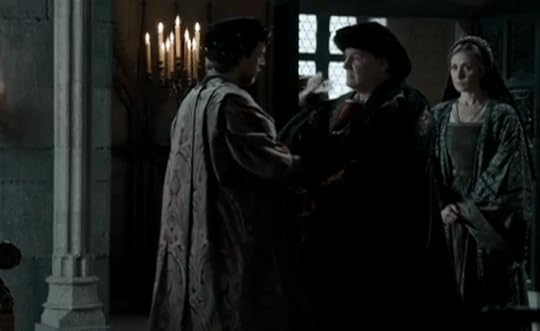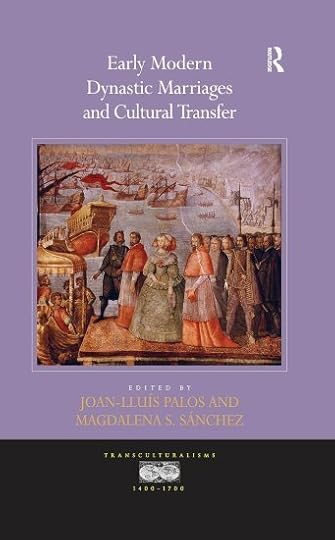Moniek Bloks's Blog, page 35
October 17, 2024
Review: Firebrand
*Spoilers*
Catherine Parr was the sixth and final wife of King Henry VIII of England. She had been married and widowed twice before marrying the King. Their wedding took place on 12 July 1543 at Hampton Court. Catherine gained two stepdaughters (and a stepson) by her marriage to Henry, but she and Mary were more friends than mother and daughter. They were fond of each other despite their religious differences.
She also corresponded with Elizabeth regularly, but Elizabeth spent less time at court after she fell out of favour with her favour for nearly a year. She was recalled to court in the summer of 1544. Catherine became the binding force between Henry’s three children, and perhaps, for the first time, they had a family life. In July 1544, Catherine was left as regent of England as Henry set off for war in France. He returned home by the end of September.
Catherine’s reformist view nearly cost her her life during her Queenship. Even though Henry had declared himself Supreme Head of the Church of England, he was still a conservative in many ways. Catherine published Prayers or Meditations in 1545, becoming the first Queen of England to be a published author in her own right. She must have secured Henry’s permission first, or it would never have been released so he must have read or at least approved of the contents. The following year, her more radical work – The Lamentation of a Sinner – was completed. Henry found that Catherine’s beliefs went much further than his own, and he became concerned.
In early 1546, Anne Askew was arrested and interrogated. A second arrest in May followed, and she was asked to name other heretics. The interrogators asked about specific people – members of Catherine’s household. Anne refused to incriminate the other women, and she was put on the rack. Anne held on and so no more, but her fate was sealed.
Meanwhile, Henry was becoming impatient with Catherine and her religious discussions. Catherine was criticised for attempting to change his mind, and Henry became even more suspicious. Henry gave his consent to have Catherine arrested, and while preparations were being made, Catherine continued to discuss religious matters with Henry – unaware of the danger she was in.
Firebrand is based on the novel Queen’s Gambit by Elizabeth Fremantle and chronicles Catherine’s time as regent and her difficult relationship with Henry after his return. Catherine is portrayed by Alicia Vikander. Catherine’s reformist views bring great danger indeed after she visits her old friend, Anne Askew (portrayed by Erin Doherty), and gives her a necklace to help her escape. Anne is captured, tortured and burned at the stake. The necklace is later retrieved and used against Catherine.
The film deviates from the historical record, and this might irk some viewers. Overall, I enjoyed the building suspense in the film, as well as the excellent portrayals of Catherine Parr and Anne Askew. Of the King’s children, the movie, unfortunately, typecasts the future Queen Mary as a dark-haired Spanish fanatic, which I thought was a shame. The future Queen Elizabeth lurks in the background as she learns how to survive at court. The sets were amazing as were the clothes.
Definitely go see this if you can.
The post Review: Firebrand appeared first on History of Royal Women.
October 15, 2024
Germaine of Foix – A maligned Queen (Part two)
On 1 February 1516, Germaine and Ferdinand set out for Madrid and later settled at El Abrojo to await Charles’s arrival. It was a difficult time – Joanna was confined at Tordesillas, Charles was essentially a foreigner, and Germaine was a childless widow. There were rumours that many wished to see Ferdinand on the throne rather than Charles. Nevertheless, Germaine refused to move to Aragon as stipulated in her late husband’s will and remained in Castile as a sign of loyalty to the new King – Charles.
 The meeting as portrayed in Carlos, Rey Emperador (2015)(Screenshot/Fair Use)
The meeting as portrayed in Carlos, Rey Emperador (2015)(Screenshot/Fair Use)On 27 November 1517, Germaine arrived in Valladolid to greet Charles. He greeted her with a kiss, and would not allow her to dismount from her mule.1 Charles was accompanied by his sister, Eleanor. Charles reportedly respected Germaine so much that he spoke to her while kneeling, but this respect soon waned. However, he continued to treat her as a mother, which is what he called her. There were some rumours of an affair between them, but these have been discounted in recent years.2
On 17 June 1519, Germaine married John of Brandenburg-Ansbach, who had been part of Charles’s entourage. Like her late husband, she was criticised for remarrying, not only because John was considered to be beneath her, it was also a disgrace to her late husband’s memory. Nevertheless, the marriage was to Charles’s advantage as John was a cousin of Joachim I Nestor, Prince-elector of the Margraviate of Brandenburg, whose vote was needed for Charles’s election as Holy Roman Emperor.3
 Germaine, Charles and John as portrayed in Carlos, Rey Emperador (2015)(Screenshot/Fair Use)
Germaine, Charles and John as portrayed in Carlos, Rey Emperador (2015)(Screenshot/Fair Use)In 1520, Germaine and John travelled in Charles’s entourage to Aachen to attend his imperial coronation.
In 1523, Germaine was named Virreina and Lieutenant General of the Kingdom of Valencia and her husband its Captain General. They moved into the Archbishop’s Palace, which had been empty since 1427. It was Germaine who did most of the actual governing. She was also known to have been present during executions, and Charles had urged to act harshly to maintain order.4 He wrote to her, “We say to you that, notwithstanding said pardons and remissions, you will prosecute and punish with justice.”5
When John died in July 1525, Germaine was again accused of poisoning a husband. It did not help that she was only in mourning for a short period of time and she remarried only one year later. Her third husband was Ferdinand, Duke of Calabria and they were named joint Viceroys and Lieutenants General of Valencia.6 Germaine was never known as Duchess of Calabria as it was considered a lesser rank than that of Queen. She also held on to Her Highness as a style of address, which was used for Queens before Charles V came into power.
The Duke of Calabria was the son of Frederick, the deposed King of Naples. Frederick died shortly after being deposed in 1501. The Duke had lived in Barcelona for several years as a hostage, but he earned the favour of Charles V and was eventually released. The marriage with Germaine neutralized him as a possible claimant to Naples, as at the age of 38, she was unlikely to give him an heir.
The couple became known for their work on the Royal Palace of Valencia and the library that the Duke installed there. Germaine and Ferdinand were also known for owning several musical instruments, such as vihuelas, a chest of vihuelas de arco, two lutes (presumably Italian), an organ inherited from Naples, and several other organs and keyboard instruments, and a number of ‘Turkish’ drums. They had about 40 musicians in their employment.7 Their court became a leading centre of culture.
In September 1536, Germaine fell ill at the Royal Palace of Valencia, and she wrote her will before moving to the countryside. Germaine died on 15 October 1536 at 11 in the evening in Liria. The cause of death may have been apoplexy or a digestive illness.8 Her body was transferred to Valencia and temporarily interred in the monastery of Santa Maria de Jesus. She was transferred to the Monasterio de San Miguel de los Reyes in 1546.
This monastery was founded as a result of a clause in Germaine’s will in which she requested a Hieronymite monastery to serve as a mausoleum.
Her husband later remarried to Mencía de Mendoza.
The post Germaine of Foix – A maligned Queen (Part two) appeared first on History of Royal Women.
October 14, 2024
Taking a look at Sarah, Duchess of York as she turns 65
Sarah Margaret Ferguson was born on 15 October 1959 as the daughter of Ronald Ferguson and Susan Wright. She has an older sister named Jane.
Embed from Getty ImagesFollowing her parents’ divorce in 1974, her father remarried to Susan Deptford and had further three children. Her mother remarried to Héctor Barrantes. The divorce was difficult for Sarah, and she later revealed she had developed an eating disorder.1
Sarah attended Daneshill School and Hurst Lodge School, where she was apparently a talented swimmer and tennis player. She followed a course at Queen’s Secretarial College when she was 18 and then worked for an art gallery, public relations firms and a publishing company.
Embed from Getty ImagesSarah knew her future husband from childhood. She and Prince Andrew announced their engagement on 19 March 1986. She was presented with an engagement ring consisting of ten diamonds surrounding a Burmese ruby to complement her red hair. They were married on 23 July 1986, and as Prince Andrew had been created Duke of York, Sarah became Her Royal Highness The Duchess of York.2 Sarah wore an ivory-silk wedding dress designed by Lindka Cierach.
Embed from Getty ImagesEmbed from Getty ImagesAs Duchess of York, Sarah became a working member of the royal family and joined her husband in carrying out engagements. Their first child, Beatrice, was born on 8 August 1988, followed by a second child, Eugenie, on 23 March 1990. As they are both girls, neither can inherit the York dukedom, which is set to go extinct upon Prince Andrew’s death. During her marriage, Sarah was often ridiculed for her weight, which only made her eating disorder worse.
Embed from Getty ImagesUnfortunately, Sarah and Andrew’s marriage was soon in trouble. Their separation was announced on 19 March 1992. Their divorce became final on 30 May 1996 and Sarah published her autobiography in November of that year. Although she initially retained the style of Her Royal Highness, a new Letters Patent regarding the regulation of post-divorce royal title was issued in August removed the style from her.3 Since then, she has been styled as Sarah, Duchess of York.
Sarah still attends some family functions but lives largely out of the public eye. She currently has three grandchildren through her two daughters. She has become a prolific author of books in several genres.
Embed from Getty ImagesThe post Taking a look at Sarah, Duchess of York as she turns 65 appeared first on History of Royal Women.
Maria Manuela of Portugal – The tragic Princess of Asturias
Maria Manuela of Portugal was born on 15 October 1527 as the daughter of King John III of Portugal and his wife, Catherine of Austria. She was their second child but the first surviving one. Seven more siblings would follow, but just one brother would live long enough to father an heir.
The archbishop of Coimbra baptised Maria Manuela amidst grand celebrations. A woman named Mecia de Andrade was assigned to care for her. With the many deaths of her siblings, she was raised carefully and with anxiety about her health. Nevertheless, she survived the perils of childhood mortality. She was educated as befitting her status as a princess of Portugal and she learned Latin and Castilian. She was also educated in Christian piety and devotion as well as the skills of a “perfect married woman”, such as embroidery and sewing.1
When she was two years old, it was written that “the Princess is very well and their Highnesses are extremely pleased with her, and they are right because she is very beautiful.”2 From an early age, she was promised to her first cousin, the future King Philip II of Spain.
In 1543, the marriage between Maria Manuela and her cousin Philip was settled, which had been one of Catherine’s greatest desires, although it was quite controversial at the Portuguese court. Maria Manuela was second in the line of succession, and it was not outside the realm of possibilities that she could succeed to the Portuguese throne. Her mother had brought up Maria Manuela as a model of what a Princess should be, and she had been carefully prepared for her role as Princess of Asturias and future Queen. Dressed in a white satin dress with gold beading and rich jewels, Maria Manuela became the Princess of Asturias. Catherine wore black satin trimmed with velvet.3 She later wrote, “I’m happy to see what I wanted so much completed.”4
Although the ceremony had taken place in March, Maria Manuela did not leave Portugal until October. Catherine said goodbye to her daughter, knowing full well that they would likely never see each other again. Maria Manuela kissed her mother’s hand as she wept during their final farewell. Her father accompanied her part of the way, and it was later written that “one could clearly see the great love that the King had for the Princess and the great longing he felt for her.”5
 The wedding as portrayed in Carlos, Rey Emperador (2015)(Screenshot/Fair Use)
The wedding as portrayed in Carlos, Rey Emperador (2015)(Screenshot/Fair Use)Maria Manuela headed a procession where even the mules were draped with embroidered velvet, which arrived at the border at the end of October. She was carried across a bridge in a litter. She managed to win the love of the Castilians almost immediately. At the time, she was described as “not large in body” and “very beautiful and gentle.”6 There is no record of Philip’s first reaction to his bride, but he observed her disguise several times before officially meeting her. Following the in-person wedding, festivities went on until the early morning. Then came the bullfights and tourneys.
Finally, it was time to head back to Valladolid, and on the way there, the newlyweds stopped at Tordesillas to visit their common grandmother, Queen Joanna of Castile. She was reportedly lucid during their visit and asked them to dance for her.7 Maria Manuela had not even had her first period yet, and she underwent treatments for it during the early months of her marriage. In the summer of 1544, she had her first period, and she fell pregnant just a few months later.
 The birth of Carlos as portrayed in Carlos, Rey Emperador (2015)(Screenshot/Fair Use)
The birth of Carlos as portrayed in Carlos, Rey Emperador (2015)(Screenshot/Fair Use)On 8 July 1545, Maria Manuela gave birth to a son named Carlos. Everything seemed to have gone well, but Maria Manuela soon became ill with puerperal fever. She was bled several times in an attempt to save her life. One observer reported that “one would say they had bled her to the last drop.”8 She seemed to improve somewhat, but this did not last long. Then, “the attack became so severe that in a few hours, Extreme Unction was administered at the Princess’ request. The attack still increased until God took her to Himself on that day between four and five in the afternoon, amidst universal grief, such as Your Majesty may imagine. Her end was tranquil and Christian, and she left a will and codicil, made before her illness.”9 She died on 12 July 1545, four days after giving birth.
 The scene as portrayed in Carlos, Rey Emperador (2015)(Screenshot/Fair Use)
The scene as portrayed in Carlos, Rey Emperador (2015)(Screenshot/Fair Use)Philipo was “extremely grieved, as to prove he loved her; although judging by outward demonstration, some people thought differently.”10
Maria Manuela was first buried in the Royal Chapel of Granada but was later transferred to the Royal Crypt of the Monastery of El Escorial. Her son Carlos died childless at the age of 23.
The post Maria Manuela of Portugal – The tragic Princess of Asturias appeared first on History of Royal Women.
Germaine of Foix – A maligned Queen (Part one)
Germaine of Foix was born in 1488 as the daughter of John of Foix, Viscount of Narbonne, a son of Eleanor, Queen of Navarre, and Marie of Orléans, a sister of King Louis XII of France. A younger brother named Gaston was born the following year. They were likely more siblings, who did not survive.
Germaine and Gaston were likely born in the Castle of Mazères and spent their first years there. Their mother died in 1492. The following year, a fire devastated the Castle of Mazères and nearly took the lives of Germaine and her brother. They were rescued just in time and were sent to live at the court of King Louis XII and Anne of Brittany. Anne sent them to the Palace of Tournelles in Paris, which was a royal residence at the time. When their father passed away in 1503, he entrusted them to the King of France.
Germaine had an excellent education under Anne of Brittany and was known as “Demoiselle de Foix” at the French court.1 Germaine was taught to read, write, dance, and sing. She also knew how to play the harpsichord and the lute.
On 26 November 1504, Queen Isabella I of Castile died at the age of 53. Her heir was her second daughter, Joanna, who was considered to be unfit. Isabella’s husband, King Ferdinand II of Aragon, did not want Aragon to go Joanna and wanted to remarry to father a male heir who would supersede Joanna in the succession. A new bride was found in the form of Germaine, who was also his grand niece as Germaine’s grandmother, Queen Eleanor of Navarre, was Ferdinand’s elder half-sister.
The response to this planned match was mostly negative, as the Castilians believed Ferdinand was dishonouring the memory of his late wife.2 This led to attacks on Germaine and she was called “flamboyant”, “frivolous” and “obese.”3
On 19 October 1505, Germaine married Ferdinand by proxy at Blois. She was 18 years old, while he was 54. As a dowry, Germaine brought the rights France had or could have had over Naples, as well as the title of King of Jerusalem. Following the death of her brother, she would also claim her rights over Navarre. Germaine left France and entered Castile through Fuenterrabía, where she was received by Alonso of Aragon, the Archbishop of Zaragoza, who was also an illegitimate son of her new husband. She finally met Ferdinand on 18 March 1506 in Dueñas, and the marriage was duly consummated following the in-person wedding on 22 March. In 1507, Germaine travelled to meet her step-daughter Joanna in Burgos, who received her “graciously.”4 She and Ferdinand also visited King Louis XII, where she was described as being audacious and arrogant.5
One observer wrote, “… and did not do as Germaine de Foix, second wife of King Ferdinand, who, seeing herself elevated to such a high rank, became so proud that she never paid any heed to her country, and disdained it so much, that King Louis XII, her uncle, and Ferdinand, having met at Savonne, and she, being with the King her husband, held such greatness, that she never paid any attention to the French, not even her brother, the Duke of Nemours, Gaston of Foix, and did not deign to speak to or look at the nobles of France who were there, for which she was greatly mocked.”6
According to historian Prudencio de Sandoval, “The Queen was no beauty, somewhat lame, given to taking it easy and going to banquets, gardens and parties. This lady introduced splendid spreads to Castile, [in spite of the fact that] Castilians, and even their Kings, were very moderate in this. Few days passed on which she did not entertain or was not entertained. Her best friend was whoever spent most money in parties and banquets for her. In 1511, Burgos held a banquet in her honour, at which they spent a thousand maravedis on radishes. From this great disorder, there followed deaths [and] quarrels, for many died from overeating.”7Germana de Foix by Rosa E. Ríos Lloret, p. 65'>8 Their attempts at having another child continued with Ferdinand even using a “virility potion.”9 However, it does not appear that Germaine fell pregnant again. If John had lived, Aragon and Castile would have remained separated. The use of the so-called virility potion was also attributed to Germaine, who was accused of making her husband sick and even causing his death.10
Despite her unpopularity, Ferdinand felt confident enough in her to make her Lieutenant General of the Kingdom of Aragon while he was out of the kingdom. She had the authority to hold a Cortes, which she did several times.
At the end of 1515, King Ferdinand fell ill, and Germaine rushed to be by his side. He wrote his final will on 22 January, in which he referred to Germaine as his “very dear and beloved wife” and mentioned their son.11 He left her a very wealthy widow, and she would keep her wealth even if she remarried. He also requested from his grandson Charles that he would take care of her.
Five days after her husband’s death, Germaine moved into the monastery of Guadalupe with Ferdinand’s namesake grandson, the future Ferdinand I, Holy Roman Emperor. The younger Ferdinand had been raised in Castile, while his other siblings grew up in the Low Countries. Only his youngest sister, Catherine, also lived in Castile, but she lived with their imprisoned mother, Joanna, in Tordesillas. Germaine wrote to Charles to inform him of his grandfather’s death, and he wrote back, assuring her of his protection and that he would execute all the provisions of his grandfather’s will.
Part two coming soon.
The post Germaine of Foix – A maligned Queen (Part one) appeared first on History of Royal Women.
October 13, 2024
The Year of Isabella I of Castile – The formal betrothal with Ferdinand
In March 1469, the future King Ferdinand II of Aragon and his father, King John II, had signed the Capitulaciones de Cervera, which stated that Ferdinand had the right to administer justice in Castile, but everything else would have to be agreed upon by Isabella. He was not even allowed to leave Castile without Isabella’s permission. He was obliged to provide 100,000 florins and an army of 4,000 lancers after the consummation of the marriage. An upfront payment of 20,000 florins, along with a pearl and ruby necklace, was also expected.
Now, they just needed to be formally betrothed, which was quite the mission impossible. Ferdinand left Zaragoza dressed as a lowly groom. He rode for two days and two nights with five other people, served the meals and looked after the horses. They arrived at Burgo de Osma, where the Duke of Treviño waited with an escort of lancers. They didn’t wait there for very long and set out again in the middle of the night. On 9 October, Ferdinand arrived at Dueñas, where he was greeted by his aunt Teresa Enriquez.
 Ferdinand dressed as a servant as portrayed in Isabel (2011)(Screenshot/Fair Use)
Ferdinand dressed as a servant as portrayed in Isabel (2011)(Screenshot/Fair Use)Nevertheless, Isabella’s half-brother, King Henry IV, was not the least bit surprised by Ferdinand’s eventual arrival. About a month earlier, Isabella had written to him that she had decided to marry, and in agreement with the Treaty of the Bulls of Guisando, she, Henry and the nobles had studied four candidates. These were Ferdinand, King Afonso V of Portugal, the Duke of Berry and the future King Richard III of England. She called Henry out for trying to bully her into the Portuguese match and said that her right to choose had been ignored. She also claimed to have consulted the nobles on her own concerning a match with Ferdinand. She said, “they praised and approved of a marriage with the Prince of Aragon, King of Sicily, giving obvious reasons.” 1
Isabella knew she was about to cause a lot of trouble, and she prevailed on Henry to remember that they all shared great-grandparents and that Ferdinand came in peace and would be a faithful servant. On 12 October, she wrote to Henry that Ferdinand had arrived in Castile and asked for his blessing. She wrote, “I beg that you may approve of his coming and approve of the [good] intentions underpinning my plans.” 2 Henry did not reply to her letter.
Two days later, Isabella met Ferdinand for the first time at Juan de Vivero’s home. It was a two-hour chaperoned meeting.
On 14 October, formal promises of marriage were exchanged and recorded by a notary. The archbishop read aloud the marriage agreement and the papal dispensation due to their close blood relation (second cousins). This papal dispensation was actually a fake – supposedly issued by an earlier pope, Pius II. The papal nuncio’s silence had been bought with Aragonese gold.
The wedding was set to take place on 19 October.
The post The Year of Isabella I of Castile – The formal betrothal with Ferdinand appeared first on History of Royal Women.
October 12, 2024
Book News Week 42
Book News Week 42 – 14 October – 20 October 2024

The Life and Death of Mary, Queen of Scots
Hardcover – 15 October 2024 (UK)

A Ruler’s Consort in Early Modern Germany: Aemilia Juliana of Schwarzburg-Rudolstadt (Women and Gender in the Early Modern World)
Paperback – 14 October 2024 (UK & US)

The Hanoverian Succession: Dynastic Politics and Monarchical Culture
Paperback – 14 October 2024 (UK & US)

Early Modern Habsburg Women: Transnational Contexts, Cultural Conflicts, Dynastic Continuities (Women and Gender in the Early Modern World)
Paperback – 14 October 2024 (US & UK)

Early Modern Dynastic Marriages and Cultural Transfer (Transculturalisms, 1400-1700)
Paperback – 14 October 2024 (US & UK)

Queen Victoria’s Favourite Granddaughter: Princess Victoria of Hesse and by Rhine, the Most Consequential Royal You Never Knew
Hardcover – 16 October 2024 (US)
The post Book News Week 42 appeared first on History of Royal Women.
October 11, 2024
Amestris Shahbanu – The tarnished reputation of King Xerxes I of the Babylonian Empire’s Queen
Amestris Shahbanu was one of the most powerful Persian Queens during the Babylonian Empire.[1] She was Queen to King Xerxes I and the mother of King Artaxerxes I. Greek historians, Herodotus and Ctesias, have portrayed her to be as a ruthless Queen who has an unquenchable thirst for blood.[2] However, modern historians believe this depiction of her to be false.[3] Nevertheless, Amestris Shahbanu continued to be influential during the reigns of both her husband and her son.[4]
On 22 September 522 B.C.E., King Bardiya of the Babylonian Empire was assassinated. This paved the way for Darius I the Great’s ascension to the Persian throne. King Darius I the Great of the Babylonian Empire rewarded the seven conspirators involved in the assassination. One of them was Otanes.[5] King Darius I the Great of the Babylonian Empire married Otanes’ daughter named Phaedymia. Octanes married King Darius I the Great of the Babylonian Empire’s sister, whose name remains unrecorded.[6] In circa 510 B.C.E., King Darius I the Great of the Babylonian Empire’s unnamed sister and Otanes welcomed a daughter named Amestris, which means “Strong Woman.”[7]
When King Darius I the Great of the Babylonian Empire died in 486 B.C.E., Amestris was already married to Crown Prince Xerxes.[8] When Crown Prince Xerxes ascended to the Persian throne, Amestris was made Shahbanu (which was the Persian title for Queen).[9] She was in her thirties.[10] Herodotus and Ctesias portrayed Amestris Shahbanu as a cruel and bloodthirsty Queen.[11] She was said to have sacrificed seven noble Persian boys to “the god of the netherworld.”[12] However, many modern historians believe there is no evidence for this claim.[13] This was because human sacrifices were forbidden in the Babylonian Empire.[14] Amestris Shahbanu bore King Xerxes I of the Babylonian Empire a son named Prince Darius, another son named Prince Artaxerxes (who would succeed King Xerxes I as King of the Babylonian Empire), and another son named Prince Achaemenes.[15] She also bore a daughter named Princess Amytis.[16]
In August 465 B.C.E., King Xerxes I of the Babylonian Empire was assassinated. Prince Darius also died. It is still unknown how he died.[17] Prince Artaxerxes ascended to the Persian throne. During the reign of King Artaxerxes I of the Babylonian Empire, Amestris Shahbanu became the most powerful and influential woman in the Persian court.[18] Prince Achaemenes was killed by the Egyptian rebels.[19] The Egyptian rebels and their Athenian allies were defeated by General Megabyzus.[20] According to Greek historians, Amestris Shahbanu was angry with General Megabyzus because he did not punish the Egyptian rebels who killed her son.[21] Five years later, King Artaxerxes I of the Babylonian Empire gave permission for Amestris Shahbanu to crucify Inaris (the leader of the Egyptian rebels) and to kill several other rebel captives.[22] Amestris Shahbanu died late in the reign of King Artaxerxes I of the Babylonian Empire in circa 424 B.C.E.[23]
Even though very little information is known about Amestris Shahbanu, it is clear that she was politically significant in the Babylonian Empire.[24] She was both a Queen and Queen Mother. She was even able to get revenge on those who murdered her son. Yet, her reputation is badly damaged because her enemies (the Greeks) have tarnished her name.[25] Despite her reputation, Amestris Shahbanu is slowly proving to historians that she was one of the most influential Persian Queens in the Babylonian Empire.[26]
Sources:
“From The Desk of THE EDITOR: POWERFUL WOMEN OF PERSIA”. (2018). Rahavard Persian Journal, 121, 347-338.
Lendering, J. (27 April, 2019). “Amestris”. Livius.org. Retrieved on 23 January 2024 from https://www.livius.org/articles/perso....
Schmitt, R. (2 August, 2011). “Amestris”. Encyclopaedia Iranica, I/9. 935-936. Retrieved on 23 January 2024 from https://www.iranicaonline.org/article....
[1] “From The Desk of THE EDITOR: POWERFUL WOMEN OF PERSIA”, 2018
[2] “From The Desk of THE EDITOR: POWERFUL WOMEN OF PERSIA”, 2018
[3] Lendering, April 27, 2019; “From The Desk of THE EDITOR: POWERFUL WOMEN OF PERSIA”, 2018
[4] Lendering, April 27, 2019; “From The Desk of THE EDITOR: POWERFUL WOMEN OF PERSIA”, 2018
[5] Lendering, April 27, 2019
[6] Lendering, April 27, 2019
[7] “From The Desk of THE EDITOR: POWERFUL WOMEN OF PERSIA”, 2018, p. 341
[8] Lendering, April 27, 2019
[9] “From The Desk of THE EDITOR: POWERFUL WOMEN OF PERSIA”, 2018
[10] Lendering, April 27, 2019
[11] “From The Desk of THE EDITOR: POWERFUL WOMEN OF PERSIA”, 2018
[12] Schmitt, August 2, 2011; p. 935
[13] Lendering, April 27, 2019; “From The Desk of THE EDITOR: POWERFUL WOMEN OF PERSIA”, 2018
[14] Lendering, April 27, 2019
[15] Lendering, April 27, 2019
[16] Schmitt, August 2, 2011
[17] Lendering, April 27, 2019
[18] Lendering, April 27, 2019
[19] Lendering, April 27, 2019
[20] Lendering, April, 27, 2019
[21] Lendering, April 27, 2019
[22] Lendering, April 27, 2019
[23] Schmitt, August 2, 2011
[24] Lendering, April 27, 2019
[25] Lendering, April 27, 2019
[26] “From The Desk of THE EDITOR: POWERFUL WOMEN OF PERSIA”, 2018
The post Amestris Shahbanu – The tarnished reputation of King Xerxes I of the Babylonian Empire’s Queen appeared first on History of Royal Women.
October 10, 2024
The Ruby Peacock Tiara
The Ruby Peacock Tiara was made in 1897 by Schürmann, reportedly from pieces from the collections of Sophie of Württemberg, the first wife of King William III of the Netherlands.
The central element of the tiara is detachable and can thus be worn separately.
Queen Wilhelmina gave this tiara to her granddaughter, Princess Irene, and she wore the tiara often. It then disappeared from the stage for a while but perhaps it has now been deposited into the family’s jewel foundation, as it has been making a few appearances.
Embed from Getty ImagesEmbed from Getty ImagesQueen Beatrix and Queen Maxima have both been spotted wearing the Ruby Peacock Tiara, as has the Princess of Orange, who wore it during the Spanish State Visit in 2024.1
Embed from Getty ImagesThe post The Ruby Peacock Tiara appeared first on History of Royal Women.
October 8, 2024
Exhibition Review: Margaret of Parma: The Emperor’s Daughter between Power and Image
Margaret was born in late July 1522 as the illegitimate daughter of Holy Roman Emperor Charles V and Johanna Maria van der Gheynst, the daughter of a carpet manufacturer. Johanna Maria worked as a maid for the Governor of Oudenaarde, who hosted the then 22-year-old and unmarried Charles for six weeks. Margaret was named for her great-aunt, Margaret of Austria. She was entrusted to the De Douvrin family in Brussels, where she lived until the age of 10. She had very little actual contact with her father.
Margaret moved to Italy in 1533, where she grew up under the guardianship of Madame de Lannoy. In 1529, she was recognised by Charles and received the right to be called “Margaret of Austria.” Despite being illegitimate, she was considered to be an excellent candidate for marriage as she was a wealthy heiress. Also, in 1529, Charles negotiated a marriage contract with Pope Clement VII for a member of the de’ Medici family and Margaret. Margaret married Alessandro de’ Medici, Duke of Florence, in 1536 under the condition that the marriage would not be consummated until Margaret was 16 years old. The marriage would not last long, as Alessandro was assassinated in 1537.
Margaret left for Rome in 1538, where she married again on 2 November 1538 to Ottavio Farnese, a grandson of Pope Paul III. The marriage began with aversion but grew over time. They would go on to have twin boys, one of whom survived to adulthood. She became Duchess consort of Parma and Piacenza in 1547. In 1556, Margaret’s half-brother, King Philip II of Spain, tried to assure himself of the Farnese family’s loyalty by sending her son to the court in Spain.
From 1555, Margaret spent a lot of time in the Netherlands. In 1559, she was named Governor of the Netherlands, and she formed a court in Brussels, where she was joined by her son. Her half-brother needed his family members to help rule his vast empire. She took over from her aunt, who had ruled with an iron fist, but Margaret herself was pretty inexperienced as a ruler. She was left with a limited authorisation from her half-brother and was told to let herself to be guided by Antoon Perrenot, Lord of Granvelle. It made it difficult for her to rule, as Philip sometimes went months without contacting her.
In 1565, Margaret’s son married Infanta Maria of Portugal in Brussels, during which several Dutch noblemen decided to ally themselves to enforce tolerance of the Protestant religion. Margaret panicked, but she had no army and had to concede. In 1566, a storm of violence known as the Beeldenstorm or Statue Storm destroyed and plundered many churches and convents. Philip decided to intervene with the military, but Margaret knew this would only make things worse. She immediately resigned as Governor of the Netherlands and departed for Italy. She returned as Governor in 1578 but left again in 1582. In 1583, she was granted permission to return to Italy for health reasons.
She died in Ortona on 18 January 1586 after a painful sickbed. Her husband died the following September, and he was succeeded as Duke of Parma by their son.
The city of Margaret’s birth is now hosting a major exhibition in honour of her life. Margaret of Parma: The Emperor’s Daughter between Power and Image will run until 5 January 2025.
The exhibition is set on two floors of the magnificent town hall of Oudenaarde.
 Photo by Moniek Bloks
Photo by Moniek BloksUpon entry, you’re offered an audio guide, which is available in several languages. On the ground floor, you’ll learn more about Margaret in the form of an introductory film. The second room introduces you to Margaret’s lineage and life at court.
Click to view slideshow.I particularly enjoyed seeing Margaret’s letter and her elegant signature.
The rest of the exhibition is located on the third floor, which is accessible via an elevator. In Margaret’s Cabinet, one can find her gorgeous Book of Hours and a rhinoceros horn cup, which belonged to her daughter-in-law, Maria of Portugal. The final room hosts some fantastic tapestries.
Click to view slideshow.Overall, the exhibition is quite impressive and well-organised. Some of the text is a little difficult to read due to their location and the white text on red plaques. There are also a few minor errors, such as King Charles II being credited for a loan and some Princesses being referred to as “Infante” rather than “Infanta.” Nevertheless, you can certainly see that this exhibition was a labour of love and it is well worth a visit.
The gift shop has a few fun items, and it also sells the accompanying publication, which is available in both Dutch and English. You can also find this online here (US) and here (UK).
The museum is in the centre of Oudenaarde and can easily be reached by public transport. Plan your visit here.
The post Exhibition Review: Margaret of Parma: The Emperor’s Daughter between Power and Image appeared first on History of Royal Women.



